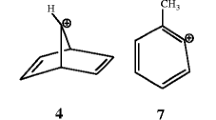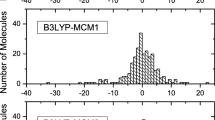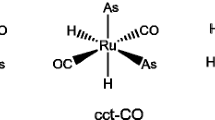Abstract
The thermodynamic stability of the PFOA family of 39 structural isomers was studied using the M06-2X, LC-ωPBE, B97D and B3LYP functionals and with the PM6 method. The PM6 results closely resemble the M06-2X results for neutral PFOAs, but diverge strongly in regard to anions. The four functionals applied behave similarly from a qualitative point of view, but quantitatively speaking, the LC-ωPBE and B97D results are somewhere between the M06-2X and B3LYP stability results. M06-2X ranks highly substituted isomers as more stable than did B3LYP and ranks less branched isomers quite low in relative stability compared to B3LYP. Various similarities with a former PFOSs study applying the M06-2X and B3LYP functionals have been identified. The degree of branching within structural isomers cannot always be precisely determined, and it is not the only aspect that determines thermodynamic stability, as the pattern of substitution also seems to play a significant role.







Similar content being viewed by others
References
Tsai WT, Chen HP, Hsien WY (2002) A review of uses, environmental hazards and recovery/recycle technologies of perfluorocarbons (PFCs) emissions from the semiconductor manufacturing processes. J Loss Prev Process Ind 15:65–75
Lindstrom AB, Strynar MJ, Libelo EL (2011) Polyfluorinated compounds, past, present, and future. Environ Sci Technol 45:7954–7961
Domingo JL (2012) Health risks of dietary exposure to perfluorinated compounds. Environ Int 40:187–195
Lau C, Anitole K, Hodes C, Lai D, Pfahles-Hutchens A, Seed J (2007) Perfluoroalkyl acids: a review of monitoring and toxicological findings. Toxicol Sci 99:366–394
Jacquet N, Maire MA, Landkocz Y, Vasseur P (2012) Carcinogenic potency of perfluorooctane sulfonate (PFOS) on Syrian hamster embryo (SHE) cells. Arch Toxicol 86:305–314
Perfluorinated Compounds (PFCs) and Human Health Concerns: Human Health and Safety initiative (2009) Global health and safety initiative. http://www.healthybuilding.net/healthcare/2009-04-20PFCs_fact_sheet. Accessed 3 Aug 2015
Environment Program Secretariat of the Stockholm Convention on Persistent Organic Pollutants (2010). Conference: the nine new POPs; An introduction to the nine chemicals added to the Stockholm convention by the conference of the parties at its fourth meeting date. United Nations. http://chm.pops.int/programmes/newpops/publications/tabid/695/language/en-us/default.aspx. Accessed 3 Aug 2015
Perfluorooctanoic Acid (PFOA) and Fluorinated Telomers (2015) United States environmental protection agency. http://www.epa.gov/oppt/pfoa. Accessed 3 Aug 2015
Rayne S, Forest K, Friesen KJ (2008) Congener-specific numbering systems for the environmentally relevant C(4) through C(8) perfluorinated homologue groups of alkyl sulfonates, carboxylates, telomer alcohols, olefins, and acids, and their derivatives. J Environ Sci Health Part A Tox Hazard Subst Environ Eng 43:1391–1401
Benskin JP, Yeung LWY, Yamashita N, Taniyasu S, Lam PKS, Martin JW (2010) Perfluorinated acid isomer profiling in water and quantitative assessment of manufacturing source. Environ Sci Technol 44:9049–9054
De Silva AO, Mabury SA (2004) Isolating isomers of perfluorocarboxylates in polar bears (Ursus maritimus) from two geographical locations. Environ Sci Technol 38:6538–6545
De Silva AO, Mabury SA (2006) Isomer distribution of perfluorocarboxylates in human blood: potential correlation to source. Environ Sci Technol 40:2903–2909
Benskin JP, De Silva AO, Martin LJ, Arsenault G, McCrindle R, Riddell N, Mabury SA, Martin JW (2009) Disposition of perfluorinated acid isomers in Sprague–Dawley rats; part 1: single dose. Environ Toxicol Chem 28:542–554
De Silva AO, Benskin JP, Martin LJ, Arsenault G, McCrindle R, Riddell N, Martin JW, Mabury SA (2009) Disposition of perfluorinated acid isomers in Sprague–Dawley rats; part 2: subchronic dose. Environ Toxicol Chem 28:555–567
De Silva AO, Tseng PJ, Mabury SA (2009) Toxicokinetics of perfluorocarboxylate isomers in rainbow trout. Environ Toxicol Chem 28:330–337
Karrman A, Elgh-Dalgren K, Lafossas C, Moskeland T (2011) Environmental levels and distribution of structural isomers of perfluoroalkyl acids after aqueous fire-fighting foam (AFFF) contamination. Environ Chem 8:372–380
De Silva AO, Muir DCG, Mabury SA (2009) Distribution of perfluorocarboxylate isomers in select samples from the North American environment. Environ Toxicol Chem 28:1801–1814
Montero-Campillo MM, Mora-Diez N, Lamsabhi AM (2010) Thermodynamic stability of neutral and anionic PFOS: a gas-phase, n-octanol, and water theoretical study. J Phys Chem A 114:10148–10155
Liu P, Goddard JD, Arsenault G, Gu J, McAlees A, McCrindle R, Robertson V (2007) Theoretical studies of the conformations and F-19 NMR spectra of linear and a branched perfluorooctanesulfonamide (PFOSAmide). Chemosphere 69:1213–1220
Rayne S, Forest K, Friesen KJ (2008) Relative gas-phase free energies for the C(3) through C(8) linear and branched perfluorinated sulfonic acids: implications for kinetic versus thermodynamic control during synthesis of technical mixtures and predicting congener profile inputs to environmental systems. J Mol Struct Theochem 869:81–82
Torres FJ, Ochoa-Herrera V, Blowers P, Sierra-Alvarez P (2009) Ab initio study of the structural, electronic, and thermodynamic properties of linear perfluorooctane sulfonate (PFOS) and its branched isomers. Chemosphere 76:1143–1149
Rayne S, Forest K (2009) Comment on “Ab initio study of the structural, electronic, and thermodynamic properties of linear perfluorooctane sulfonate (PFOS) and its branched isomers” by FJ Torres, V. Ochoa-Herrera, P. Blowers, R. Sierra-Alvarez [Chemosphere 76 (8) (2009) 1143–1149]. Chemosphere 77:1455–1456
Ipatieff VN, Grosse AV (1936) Action of aluminum chloride on paraffins: autodestructive alkylation. Ind Eng Chem 28:461–464
Olah GA, Molnur A (1995) Hydrocarbon chemistry. Wiley, New York
Afeefy HY, Liebman JF, Stein SE (1996) Neutral thermochemical data: NIST chemistry webbook. NIST Standard Reference Database Number 69. National Institute of Standards and Technology, Gaithersburg
Fliszar S (1983) Charge distribution and chemical effects. Springer, Berlin
Ess DH, Liu S, De Proft F (2010) Density functional steric analysis of linear and branched alkanes. J Phys Chem A 114:12952–12957
Giroday T, Montero-Campillo MM, Mora-Diez N (2014) Thermodynamic stability of PFOS: M06-2X and B3LYP comparison. Comput Theor Chem 1046:81–92
Wiberg KB (1991) Substituent effects. 2. n-butyl and tert-butyl derivatives. J Org Chem 56:544–550
Zhao Y, Truhlar DG (2008) Density functionals with broad applicability in chemistry. Acc Chem Res 41:157–167
Raghavachari K, Stefanov BB, Curtiss LA (1997) Accurate density functional thermochemistry for larger molecules. Mol Phys 91:555–559
Curtiss LA, Raghavachari K, Redfern PC, Pople JA (1997) Assessment of Gaussian-2 and density functional theories for the computation of enthalpies of formation. J Chem Phys 106:1063–1079
Saeys M, Reyniers MF, Marin GB, van Speybroeck V, Waroquier J (2003) Ab initio calculations for hydrocarbons: enthalpy of formation, transition state geometry, and activation energy for radical reactions. J Phys Chem A 107:9147–9159
Grimme S (2006) Semiempirical GGA-type density functional constructed with a long-range dispersion correction. J Comput Chem 27:1787–1799
Feng Y, Liu L, Wang JT, Huang H, Guo QX (2003) Assessment of experimental bond dissociation energies using composite ab initio methods and evaluation of the performances of density functional methods in the calculation of bond dissociation energies. J Chem Inf Comput Sci 43:2005–2013
Izgorodina EI, Coote ML, Radom L (2005) Trends in R–X bond dissociation energies (R = Me, Et, i-Pr, t-Bu; X = H, CH3, OCH3, OH, F): a surprising shortcoming of density functional theory. J Phys Chem A 109:7558–7566
Schwabe T, Grimme S (2007) Double-hybrid density functionals with long-range dispersion corrections: higher accuracy and extended applicability. Phys Chem Chem Phys 9:3397–3406
Rayne S, Forest K (2010) Comparative semiempirical, ab initio, and density functional theory study on the thermodynamic properties of linear and branched perfluoroalkyl sulfonic acids/sulfonyl fluorides, perfluoroalkyl carboxylic acid/acyl fluorides, and perhydroalkyl sulfonic acids, alkanes, and alcohols. J Mol Struct Theochem 941:107–118
Frisch MJ, Trucks GW, Schlegel HB, Scuseria GE, Robb MA, Cheeseman JR, Scalmani G, Barone V, Mennucci B, Petersson GA, Nakatsuji H, Caricato M, Li X, Hratchian HP, Izmaylov AF, Bloino J, Zheng G, Sonnenberg JL, Hada M, Ehara M, Toyota K, Fukuda R, Hasegawa J, Ishida M, Nakajima T, Honda Y, Kitao O, Nakai H, Vreven T, Montgomery JA Jr, Peralta JE, Ogliaro F, Bearpark M, Heyd JJ, Brothers E, Kudin KN, Staroverov VN, Kobayashi R, Normand J, Raghavachari K, Rendell A, Burant JC, Iyengar SS, Tomasi J, Cossi M, Rega N, Millam JM, Klene M, Knox JE, Cross JB, Bakken V, Adamo C, Jaramillo J, Gomperts R, Stratmann RE, Yazyev O, Austin AJ, Cammi R, Pomelli C, Ochterski JW, Martin RL, Morokuma K, Zakrzewski VG, Voth GA, Salvador P, Dannenberg JJ, Dapprich S, Daniels AD, Farkas Ö, Foresman JB, Ortiz JV, Cioslowski J, Fox DJ (2009) Gaussian 09, revision A.1. Gaussian, Inc., Wallingford
Becke AD (1993) Density functional thermochemistry. 3. The role of exact exchange. J Chem Phys 98:5648–5652
Lee C, Yang WT, Parr RG (1988) Development of the Colle–Salvetti correlation-energy formula into a functional of the electron-density. Phys Rev B 37:785–789
Vydrov OA, Scuseria GE (2006) Assessment of a long-range corrected hybrid functional. J Chem Phys 125:234109
Zhao Y, Truhlar DG (2008) The M06 suite of density functionals for main group thermochemistry, thermochemical kinetics, noncovalent interactions, excited states, and transition elements: two new functionals and systematic testing of four M06-class functionals and 12 other functionals. Theor Chem Acc 120:215–241
Stewart JJP (2007) Optimization of parameters for semiempirical methods V: Modification of NDDO approximations and application to 70 elements. J Mol Model 13:1173–1213
Perdew JP, Burke K, Ernzerhof M (1996) Generalized gradient approximation made simple. Phys Rev Lett 77:3865–3868
Perdew JP, Burke K, Ernzerhof M (1997) Generalized gradient approximation made simple (vol 77, pg 3865, 1996). Phys Rev Lett 78:1396
Zhao Y, Truhlar DA (2006) Density functional that accounts for medium-range correlation energies in organic chemistry. Org Lett 8:5753–5755
Huenerbein R, Schirmer B, Moellmann J, Grimme S (2010) Effects of London dispersion on the isomerisation reactions of large organic molecules: a density functional benchmark study. Phys Chem Chem Phys 12:6940–6948
Rayne S, Forest K (2010) Theoretical studies on the pKa values of perfluoroalkyl carboxylic acids. J Mol Struct Theochem 948:102–107
Zhao Y, Schultz NE, Truhlar DG (2006) Design of density functionals by combining the method of constraint satisfaction with parametrization for thermochemistry, thermochemical kinetics, and noncovalent interactions. J Chem Theory Comput 2:364–382
Marenich AV, Cramer CJ, Truhlar DG (2009) Universal solvation model based on solute electron density and on a continuum model of the solvent defined by the bulk dielectric constant and atomic surface tensions. J Phys Chem B 113:6378–6396
Ellis DA, Denkenberger KA, Burrow TE, Mabury SA (2004) The use of F-19 NMR to interpret the structural properties of perfluorocarboxylate acids: A possible correlation with their environmental disposition. J Phys Chem A 108:10099–10106
Wodrich MD, Wannere CS, Mo Y, Jarowski PD, Houk KN, Schleyer PVR (2007) The concept of protobranching and its many paradigm shifting implications for energy evaluations. Chem Eur J 13:7731–7744
Acknowledgments
The authors gratefully acknowledge the Natural Sciences and Engineering Research Council of Canada (NSERC) for financial support and would like to thank Information Technology Services at Thompson Rivers University.
Author information
Authors and Affiliations
Corresponding author
Electronic supplementary material
Below is the link to the electronic supplementary material.
Rights and permissions
About this article
Cite this article
Hidalgo, A., Giroday, T. & Mora-Diez, N. Thermodynamic stability of neutral and anionic PFOAs. Theor Chem Acc 134, 124 (2015). https://doi.org/10.1007/s00214-015-1725-4
Received:
Accepted:
Published:
DOI: https://doi.org/10.1007/s00214-015-1725-4




